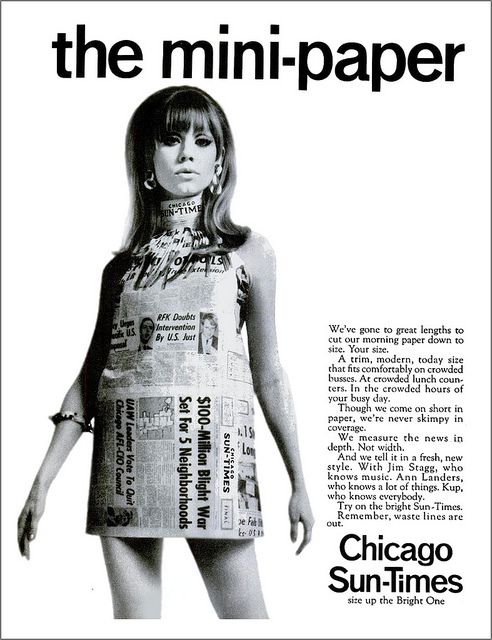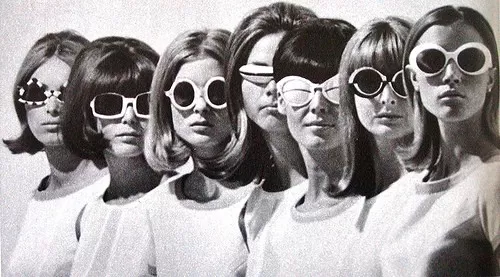Written by Amy Britton



The 1960s was the decade for change. With the youth revolution occurring across western societies, young people’s ideology was rapidly changing throughout this period. And so did the fashion. One of the most famous subcultures arising in London during this time was mod culture.
Mods were young, dyspeptic baby boomers that used their different culture in order to combat their parents principles. Bands such as The Small Faces and The Kinks helped to inspire these adolescents and their way of dressing. Not only did they aid the beginning of this movement, but most notably, The Who regenerated it with the iconic concept album, Quadrophenia (1973), and subsequent 1979 film of the same name. But aside from the music, fashion was one of the most important aspects of the mod identity. For most teenagers these days, fashion is a way to express one’s personality, and it was no different from women’s mod fashion in the 60s.
Although the movement did not originally include women, young women became increasingly involved with the movement and helped to construct the popular fashions for women throughout the 1960s and 70s. Famous mod fashion designer, Mary Quant, suggested that it was the mod women that gave rise to the popularity of the miniskirt rather than fashion weeks and high-end designers. With the 50s being the decade for traditionalist ideas, the 60s led to an outburst of young people wanting to distribute their liberal opinions and for mod women, they did this through what they wore.
Hemlines got shorter and parents got more aggravated. Mod women exhibited their political standings through their outrageous clothes in order to highlight how they were tired of fitting into the social norms of the 50s. A mod girl was seen as courageous and audacious for being brave enough for trying new clothes and showing a little more skin than what was socially acceptable. Shifting political attitudes can be seen in the shifting fashions. Despite gaining the right to vote, women’s opinions were still not fully respected and therefore, by wearing outrageous outfits, it gave mod women a spotlight to share their ideas and be listened to.
Many young women wore bright colours and bold statement pieces to emphasize their rebellious side. Mod clothes were modified to make them easier to wear and more comfortable, allowing women to ride the famous GS scooters. This frightened their conservative parents, who were worried about the freedom that this would give women. Mod women were breaking gender stereotypes that had been entrenched in society, all through the means of their fashion. Peter pan collars were particularly popular, as they gave mod women a more childish look, amplifying their desire to stay young and avoid changes. Mod outfits horrified older generations and caused disruption. These mod women wore anything to upset their conservative parents, showing their desperation to be different from those that came before them.
Image Courtesy of National Portrait Gallery
Hairstyles were also a way for women to take control of their lives. Many women opted for short hair and pixie cuts for a more androgynous style in order to uproot femininity. A prime example of this being the model Twiggy. Mod women preferred neutral makeup whilst mod men adorned their faces with heavy eye makeup and bright colours. This reverse of gender roles highlights the need to be different and go against the conservative attitudes that had been planted in society.
Even today, fashion is used by women as a form of self-expression, whether your clothes highlight the music that you like or your culture. Still, vintage shops sell mod-esque clothing and designers take fragments from 60s styles and modify them to fit modern tastes. Remains of mod culture continue to be scattered around towns like Brighton on the south coast of England with Quadrophenia Alley being a popular tourist spot.
Whilst fashion may be overlooked by many historians, it can give us essential insight into the mindsets of those that create these outfits. There was the meaning behind the choices made by young women in the 60s, especially in terms of their clothes.
Mod women were feminists of fashion, using colours and fabrics to fight their parent’s politics. For me, it would be ignorant to believe that fashion trends are meaningless or even materialistic but instead, these trends exhibit the political ideas and changes that were occurring at this time.
Sources:
The Mini Mod Sixties Book – Samantha Bleikorn
A Concise History of the British Mod Movement – Melissa M. Casburn


My sister was a mod woman – her hot-pants outfits caused our parents a lot of grief! I had short hair and modelled myself on Twiggy. In honour of Twiggy, I have named my cat after her!
LikeLike
Nice article! Thanks for sharing. Very helpful to me.
LikeLike